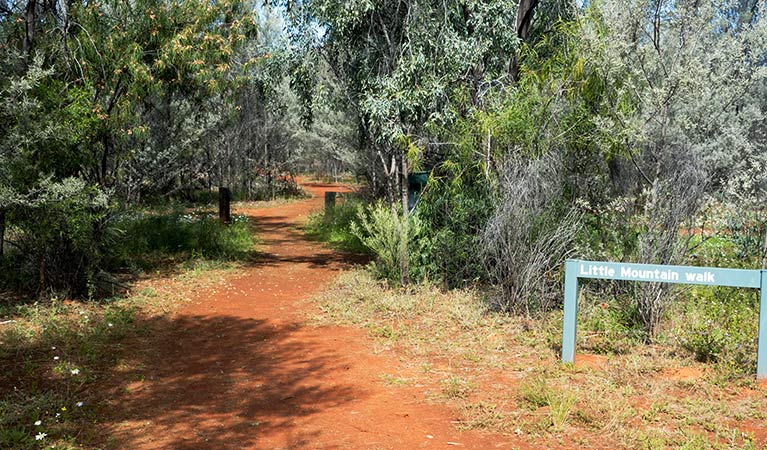Overview
Ideal for outback birdwatching and walking with kids, Little Mountain walking track offers a gentle walk with scenic views of Gundabooka National Park, near Bourke.
- Where
- Gundabooka National Park in Outback NSW
- Distance
- 4.8km return
- Time suggested
- 2 - 3hrs
- Grade
- Grade 4
- Opening times
Little Mountain walking track is always open, but may have to close at times due to wet weather or park operations.
- What to
bring - Drinking water, hat, sunscreen, suitable clothing
- Please note
- Please keep an eye out for brown snakes on this walk. It's advisable to wear sturdy covered shoes.
- Remember to take your binoculars if you want to go birdwatching
The picturesque Little Mountain walking track runs from Dry Tank campground to Little Mountain lookout in Gundabooka National Park, near Bourke. It's hard not to be moved by the beauty and tranquility of the bush as you amble along this red-soil track.
Keep your camera handy to snap a few photos as you're likely to encounter kangaroos, emus and reptiles on this easy walk. Plus, if you enjoy birdwatching, you'll certainly be kept busy spotting finches, robins and mallee ring-necks.
The spring and autumn seasons are ideal for venturing through Little Mountain walking track, and it's a great nature walk to share with the kids. The colourful wildflower displays will surprise you, and you'll discover some interesting facts about the area if you take time to read the informative signage along the way.
Follow this walking track through wild mulga woodland, watching as the magnificent Gunderbooka Range rises up from the plains.The lookout at the end offers scenic views of the range’s entire northern escarpment, and is particularly beautiful at sunset.
Take a virtual tour of Little Mountain walking track captured with Google Street View Trekker.
Also see
-

Little Mountain lookout
Little Mountain lookout is at the end of Little Mountain walking track, in Gundabooka National Park. It’s a great spot to soak up stunning views of Gunderbooka Range.
-

Dry Tank campground
Stay overnight in Gundabooka National Park at Dry Tank campground. Bring your tent, caravan or trailer to enjoy a night of national park camping near Bourke in outback NSW.
-

Dry Tank picnic area
Take in the beauty of the Gundabooka National Park landscape at Dry Tank picnic area. Enjoy a picnic or barbecue lunch and watch the birds before walking to Mt Gunderbooka.
Map
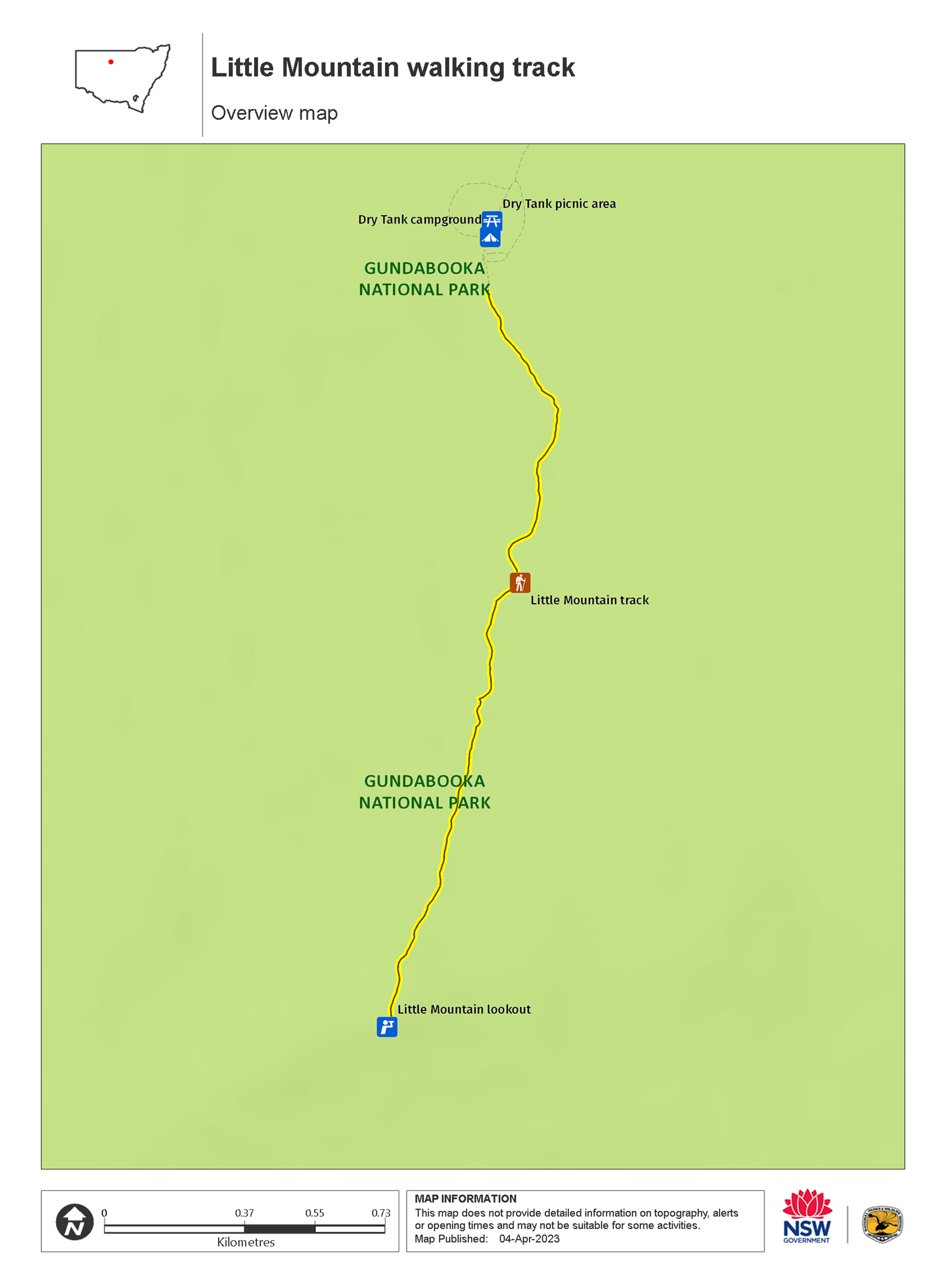
Map legend

Local alerts
For the latest updates on fires, closures and other alerts in this area, see https://www.nationalparks.nsw.gov.au/things-to-do/walking-tracks/little-mountain-walking-track/local-alerts
General enquiries
- National Parks Contact Centre
- 7am to 7pm daily
- 1300 072 757 (13000 PARKS) for the cost of a local call within Australia excluding mobiles
- parks.info@environment.nsw.gov.au
Park info
- in Gundabooka National Park in the Outback NSW region
Gundabooka National Park is always open but may have to close at times due to poor weather or fire danger.
Visitor info
All the practical information you need to know about Little Mountain walking track.
Track grading
Features of this track
Distance
4.8km return
Time
2 - 3hrs
Quality of markings
Limited signage
Experience required
No experience required
Gradient
Gentle hills
Steps
Occasional steps
Quality of path
Formed track, some obstacles
Getting there and parking
Little Mountain walking track begins at Dry Tank campground in the western part of Gundabooka National Park. To get there:
From Bourke:
- Drive south from Bourke on Kidman Way for approximately 49km and turn right onto Ben Lomond Road
- Continue along Ben Lomond Road for approximately 19.5km until you reach until you reach Dry Tank Trail
- Continue for 2.5 km past Dry Tank campground and picnic area until you reach the parking area
From Gundabooka:
- Drive north on Kidman Way for approximately and turn left onto Ben Lomond Road
- Continue along Ben Lomond Road for approximately 19.5km until you reach Dry Tank Trail
- Continue for 2.5 km past Dry Tank campground and picnic area until you reach the parking area
Check the weather and road conditions before you set out as the roads to Gundabooka National Park may be closed.
Road quality
Check the weather before you set out as the road can become boggy when it rains
Parking
Parking is available at Dry Tank campground - the starting point for Little Mountain walking track.
Best times to visit
There are lots of great things waiting for you in Gundabooka National Park. Here are some of the highlights.
Autumn
It's a great time to visit the park with the weather being a bit cooler, and after summer rain, the park may be looking a little greener than usual.
Spring
Join in on a Discovery tour to find out more about the park, the amazing landscape and the animals who live here.
Winter
Crisp clear days await you, it's perfect weather for walking and if you don't feel like camping out, you can book into the comfort of Redbank Homestead.
Weather, temperature and rainfall
Summer temperature
Average
20°C and 33°C
Highest recorded
47°C
Winter temperature
Average
6°C and 17°C
Lowest recorded
-2.5°C
Rainfall
Wettest month
January and February
Driest month
June
The area’s highest recorded rainfall in one day
108.8mm
Maps and downloads
Prohibited
Gathering firewood
Firewood is not supplied and may not be collected from the park.
Pets
Pets and domestic animals (other than certified assistance animals) are not permitted. Find out which regional parks allow dog walking and see the pets in parks policy for more information.
Smoking
NSW national parks are no smoking areas.
Learn more
Little Mountain walking track is in Gundabooka National Park. Here are just some of the reasons why this park is special:
An emphasis on conservation
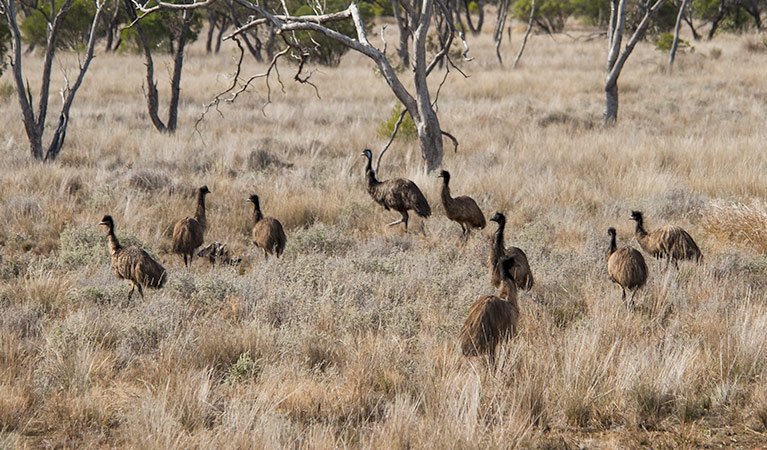
A visit to Gundabooka National Park offers the wonderful opportunity to spot some of Australia's rarest birds and animals. Several threatened species - including the little pied bat, kultarr, pink cockatoo and painted honeyeater - have been recorded in the area. The park also includes 21 different plant communities, including threatened plant species like the curly bark wattle.
- Little Mountain walking track Ideal for outback birdwatching and walking with kids, Little Mountain walking track offers a gentle walk with scenic views of Gundabooka National Park, near Bourke.
An important place
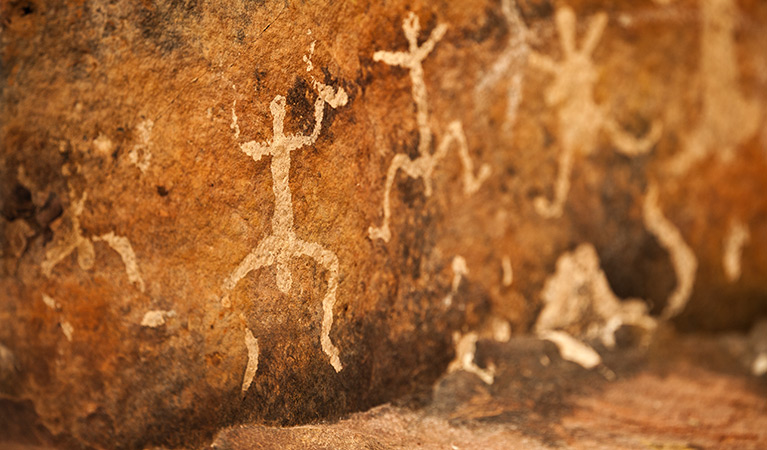
Gunderbooka range is highly significant to the Ngemba and Kurnu Baakandji people of western NSW. Before it became a national park, the area was home to the Ngemba and Kurnu Baakandji people of western NSW. Ceremonial events were held within the range. On your visit, you'll see Aboriginal rock art, with motifs including dancers and animals.
- Yapa (Mulgowan) Aboriginal art site walking track Yapa (Mulgowan) Aboriginal art site walking track offers a unique Outback experience with Aboriginal rock art and birdwatching in Gundabooka National Park, near Bourke.
Pastoral history
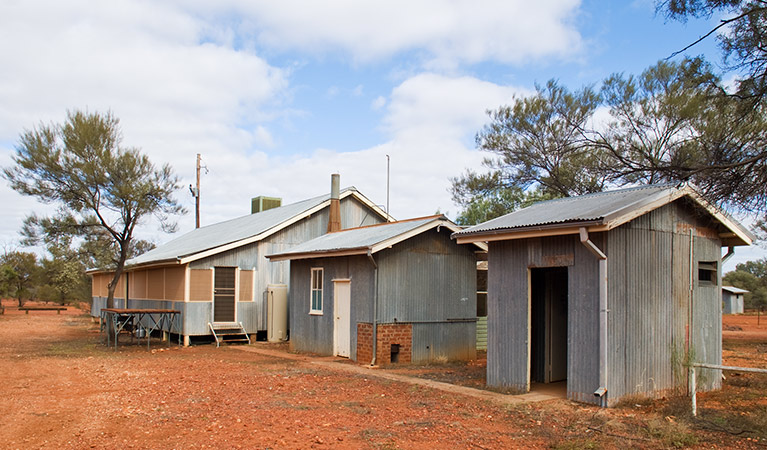
Though noted by Charles Sturt in 1829, the Gunderbooka range wasn't used by pastoralists until the late 1800s. The range was included in neighbouring sheep stations which were then subdivided after World War I. Today, three of these smaller stations - Ben Lomond, Belah and Mulgowan - make up Gundabooka National Park. Check out the old homesteads, quarters, fences, tanks, shearing sheds and yards on your visit.
Rewarding walks
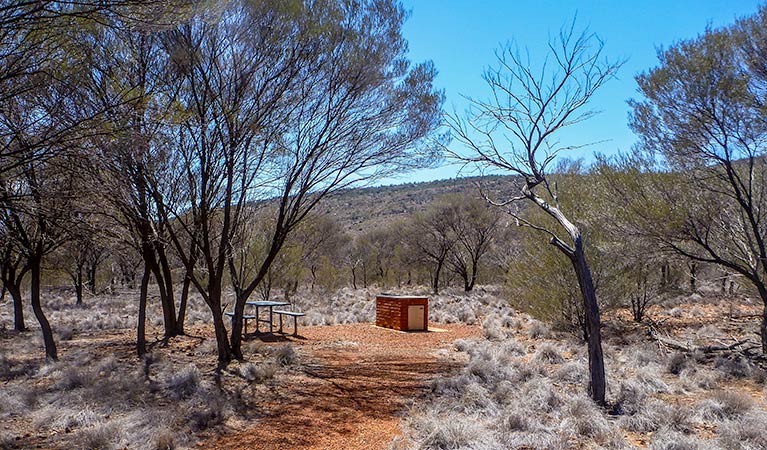
There are a number of opportunities to stretch your legs along one of the well-signed walks in Gundabooka National Park. Take the wonderful Mulareenya Creek Art Site track and see fascinating Aboriginal rock art. Walking the Little Mountain track is also well worth the effort with impressive views awaiting you at the summit.
- Bennetts Gorge picnic area Stop and relax at Bennetts Gorge picnic area when you visit Gundabooka National Park. Enjoy a barbecue or bring a picnic hamper before walking on to Mt Gunderbooka.
- Valley of the Eagles walk Valley of the Eagles walk starts at the popular Bennetts Gorge picnic area and explores the imposing Mount Gunderbooka in Gunabooka National Park.
The beautiful outback
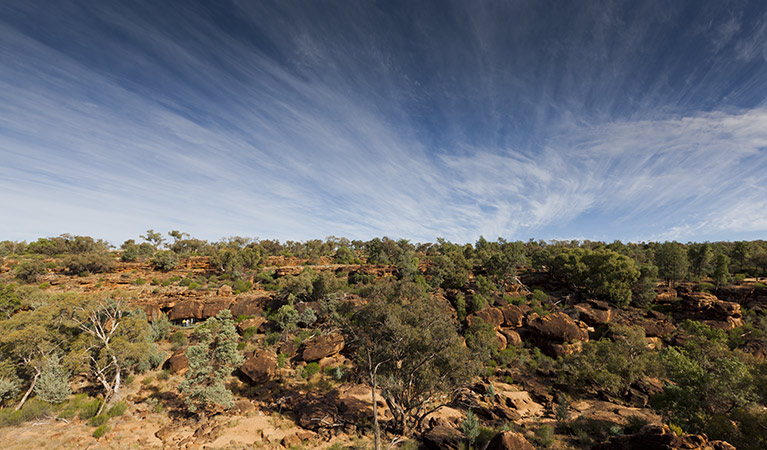
Gundabooka National Park is located in northwest NSW, approximately 50km southwest of Bourke and 110km northwest of Cobar. The 63,903ha national park extends from the Darling river banks to the Gunderbooka range. Vast stretches of grassy woodlands, open plains and rust-coloured rock dominate the landscape.
- Little Mountain walking track Ideal for outback birdwatching and walking with kids, Little Mountain walking track offers a gentle walk with scenic views of Gundabooka National Park, near Bourke.
Plants and animals protected in this park
Animals
-

Emu (Dromaius novaehollandiae)
The largest of Australian birds, the emu stands up to 2m high and is the second largest bird in the world, after the ostrich. Emus live in pairs or family groups. The male emu incubates and rears the young, which will stay with the adult emus for up to 2 years.
-

Wedge-tailed eagle (Aquila audax)
With a wingspan of up to 2.5m, the wedge-tailed eagle is Australia’s largest bird of prey. These Australian animals are found in woodlands across NSW, and have the ability to soar to heights of over 2km. If you’re bird watching, look out for the distinctive diamond-shaped tail of the eagle.
-

Red kangaroo (Macropus rufus)
The red kangaroo is one of the most iconic Australian animals and the largest marsupial in the world. Large males have reddish fur and can reach a height of 2m, while females are considerably smaller and have blue-grey fur. Red kangaroos are herbivores and mainly eat grass.
Plants
-

Mulga (Acacia aneura)
Mulga are hardy Australian native plants found throughout inland Australia. With an unusually long tap root, the mulga is able to withstand long periods of drought.

